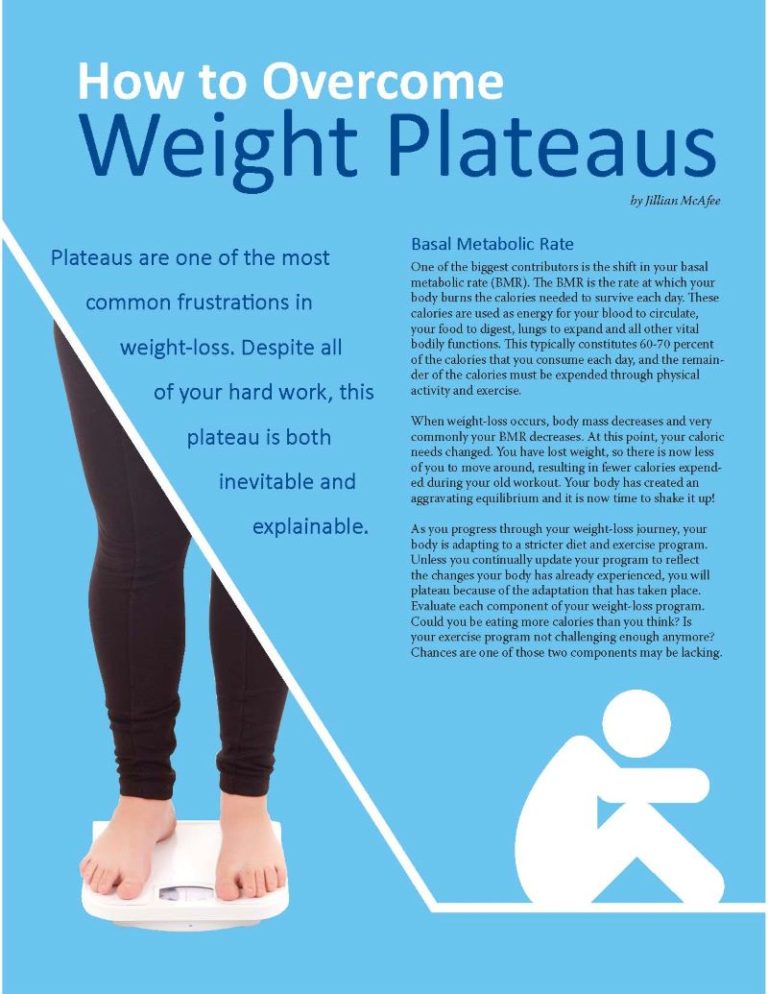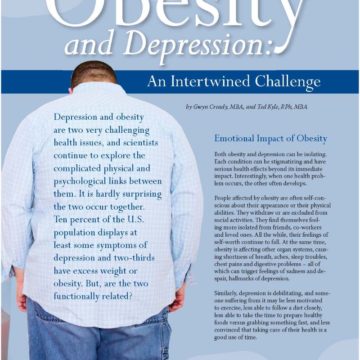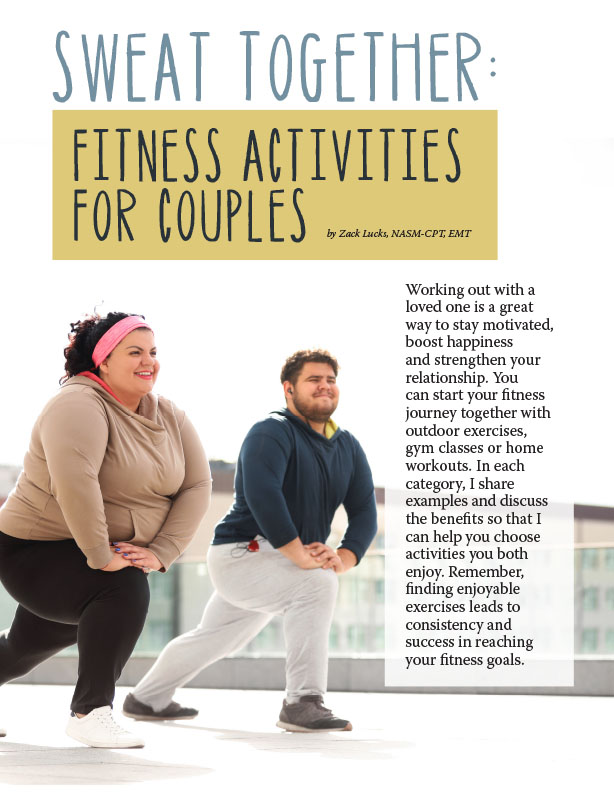How to Overcome Weight Plateaus


by Jillian McAfee
Summer 2012
Plateaus are one of the most common frustrations in weight-loss. Despite all of your hard work, this plateau is both inevitable and explainable.
Basal Metabolic Rate
One of the biggest contributors is the shift in your basal metabolic rate (BMR). The BMR is the rate at which your body burns the calories needed to survive each day. These calories are used as energy for your blood to circulate, your food to digest, lungs to expand and all other vital bodily functions. This typically constitutes 60-70 percent of the calories that you consume each day, and the remainder of the calories must be expended through physical activity and exercise.
When weight-loss occurs, body mass decreases and very commonly your BMR decreases. At this point, your caloric needs changed. You have lost weight, so there is now less of you to move around, resulting in fewer calories expended during your old workout. Your body has created an aggravating equilibrium and it is now time to shake it up!
As you progress through your weight-loss journey, your body is adapting to a stricter diet and exercise program. Unless you continually update your program to reflect the changes your body has already experienced, you will plateau because of the adaptation that has taken place. Evaluate each component of your weight-loss program. Could you be eating more calories than you think? Is your exercise program not challenging enough anymore? Chances are one of those two components may be lacking.
Calorie Counts
Let’s take a look at your consumption of calories. Calories are hidden into foods such as dressings, sauces and condiments. Portion sizes are much smaller than what you would think. Are you snacking throughout the day resulting in an extra 500 calories consumed?
Now let’s look at your caloric burn. Cardio machines at the gym tend to overestimate the number of calories that you expend during a workout. Think about it, if you had a product that you wanted to sell to promote weight-loss, wouldn’t you do anything to make the consumer believe that they are using the very best product?
A common mistake is to underestimate the calories eaten and overestimate the calories burned. It would be a good idea to begin food journaling and logging your exercise. By recording your consumption, it creates both accountability and awareness of what you are putting in your body. To lose a pound of weight, you have to create a caloric deficit of 3,500 calories each week by consuming fewer calories and burning more.
The Shock Factor A change in both your diet and workout can kick-start the weight-loss again. To avoid plateaus, try modifying one of the following factors of your workout program:
- Frequency of Exercise
- Intensity
- Type of Exercise
- Duration of Workout
In some cases, a small adjustment may be all you need, but variety is the key. Not only does variety keep you interested, but it keeps your body intrigued as well.
For example, change things up by alternating strength training days with cardio days, try a whole new mode of exercise such as water aerobics, or spice up your cardio with interval training.
Interval training is known to be the most efficient form of cardio because you are able to burn calories and fat at a faster rate than you would during a longer workout at a sustained intensity.
Don’t be Afraid of the Weights
If you haven’t started strength training, do so! Strength training has been shown to help patients manage their weight by offsetting the decrease in their metabolic rate. Muscle is metabolically active tissue; therefore, the more of it you have, the more efficient your metabolism will be. If you were to gain a pound of muscle, it can be estimated that this would increase your BMR by 50 calories!
You can choose from many different modes of strength training such as strength machines, free weights, medicine balls, kettle bells and resistance bands. If you do not have access to such equipment, you can do simple body weight exercises and use household objects such as soup cans or milk jugs to add extra resistance. Try to incorporate strength exercises into your program three to four times each week.
Increase your Physical Activity
Increasing your activity level is one of the best things you can do for yourself. Wear a pedometer to track your steps each day. You can create small changes such as taking the stairs, parking at the back of the lot when going to the grocery store, pacing while you are talking on the phone or using a push lawn mower instead of a riding mower. Your ultimate goal is to accumulate 10,000 steps each day, but if this seems extreme right now, you can reevaluate that goal. Track your steps for a day and try to increase the number of steps each day after that. Sometimes it takes extra effort to increase your physical activity due to society’s sedentary habits.
Everyone is Motivated
Lack of motivation is not an excuse. If you are reading this article, you have motivation! Reassess the reasons that you want to lose weight. They may have changed since you initially started this journey and realizing this may help you stay focused! Set small realistic goals and reward yourself once each goal is achieved.
Plateaus aren’t Always Bad
That’s right! There comes a point where a plateau is a good thing. A plateau in weight-loss is an opportunity to reevaluate your progress. Talk with your physician about whether or not you have reached a healthy goal weight. If this is the case, refocus your efforts to maintaining what you’ve achieved and be proud of yourself for your hard work.
Remember that reaching your goal weight does not translate into reaching the end of your weight-loss journey. This is a lifestyle that you have chosen and it is normal to have ups and downs. Be thankful for your body and don’t take it for granted!
About the Author:
Jillian McAfee is a Fitness and Health Specialist at IU Health Bariatric & Medical Weight-loss. She received her bachelor of science degree in kinesiology from Indiana University, and is a certified personal trainer through The American College of Sports Medicine. Jillian is passionate about inspiring individuals to live a healthy and active lifestyle.
by Yelena Kibasova Spring 2024 The fitness world is evolving, with new trends and innovations that promise…
Read Articleby Kendall Griffey, OAC Communications Manager Spring 2024 We have officially kicked off Your Weight Matters Regional…
Read Articleby Zack Lucks, NASM-CPT, EMT Winter 2024 Working out with a loved one is a great way…
Read Article









